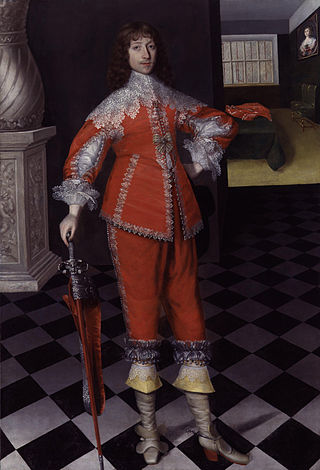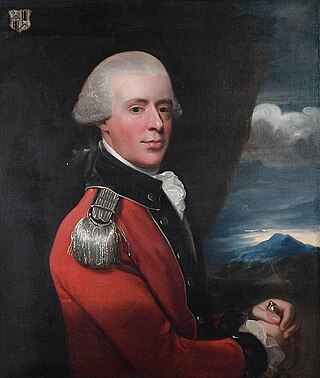Armine baronets, of Osgodby (1619)

- Sir William Armine, 1st Baronet (1593–1651)
- Sir William Armine, 2nd Baronet (1622–1658)
- Sir Michael Armine, 3rd Baronet (1625–1668)
The Armine baronetcy (also spelt Armyn or Airmine), of Osgodby in the County of Lincoln, was a title in the Baronetage of England. It was created on 28 November 1619 for William Armine, subsequently Member of Parliament for Boston, Grantham and Lincolnshire. The second baronet represented Cumberland in Parliament. The title became extinct on the death of the third baronet in 1668. [1]
Susan, daughter of the second baronet and wife of Sir Henry Belasyse, was created Baroness Belasyse for life on 25 March 1674. [2]


Earl of Lonsdale is a title that has been created twice in British history, firstly in the Peerage of Great Britain in 1784, and then in the Peerage of the United Kingdom in 1807, both times for members of the Lowther family.

Earl of Kimberley, of Kimberley in the County of Norfolk, is a title in the Peerage of the United Kingdom. It was created in 1866 for the prominent Liberal politician John Wodehouse, 3rd Baron Wodehouse. During his long political career, he notably held office as Lord Lieutenant of Ireland, Secretary of State for the Colonies, Secretary of State for India and Secretary of State for Foreign Affairs. He was succeeded by his son, the second Earl. At first a Liberal like his father, he later joined the Labour Party, becoming the first Labour member of the House of Lords. His eldest son, the third Earl, represented Norfolk Mid in the House of Commons as a Liberal. Since 2002, the titles are held by the latter's grandson, the fifth Earl.

Viscount Fauconberg, of Henknowle in the Bishopric of Durham, was a title in the Peerage of England held by the head of the Belasyse family. This family descended from Sir Henry Belasyse, High Sheriff of Yorkshire from 1603 to 1604, who was created a Baronet, of Newborough in the County of York, in the Baronetage of England in 1611. His son, Sir Thomas, the second Baronet, was created Baron Fauconberg, of Yarm in the County of York, in the Peerage of England in 1627. In 1643 he was further honoured when he was made Viscount Fauconberg, of Henknowle in the Bishopric of Durham, also in the Peerage of England. He was succeeded by his grandson, Thomas, the second Viscount, the son of Henry Belasyse. Thomas was created Earl Fauconberg in the Peerage of England in 1689. He was childless and the earldom became extinct on his death in 1700. He was succeeded in the remaining titles by his nephew and namesake, Thomas, the third Viscount, the son of Sir Rowland Belasyse. The third Viscount was succeeded by his son, Thomas, the fourth Viscount, who in 1756 was created Earl Fauconberg, of Newborough in the County of York, in the Peerage of Great Britain. The Earl's son Thomas, the second Earl, had no sons and the earldom became extinct on his death in 1802. He was succeeded in the remaining titles by his second cousin Rowland Belasyse, the sixth Viscount, the grandson and namesake of Rowland Belasyse, younger brother of the third Viscount. The sixth Viscount was succeeded by his younger brother, Charles the seventh Viscount, on whose death in 1815 all the titles became extinct.

John Belasyse, 1st Baron Belasyse was an English nobleman, Royalist officer and Member of Parliament, notable for his role during and after the Civil War. He suffered a long spell of imprisonment during the Popish Plot, although he was never brought to trial. From 1671 until his death he lived in Whitton, near Twickenham in Middlesex. Samuel Pepys was impressed by his collection of paintings, which has long since disappeared.

There have been twenty one baronetcies created for persons with the surname Williams, eight in the Baronetage of England, three in the Baronetage of Great Britain and ten in the Baronetage of the United Kingdom. Only six of the creations are extant as of 2017.

The Norwich Baronetcy, of Brampton in the County of Northampton, was a title in the Baronetage of England. It was created on 24 July 1641 for John Norwich, Member of Parliament for Northamptonshire and Northampton. The second Baronet was member of parliament for Northampton. The title is presumed to have become extinct on the death of the fourth Baronet in 1742.

Lord Banff is an extinct or dormant title in the Peerage of Scotland. It was created on 31 August 1642 for Sir George Ogilvy, 1st Baronet. He had already been created a Baronet, of Forglen in the County of Banff, in the baronetage of Nova Scotia on 30 July 1627. He was succeeded by his son, the second Lord. He was a cavalier and member of the Parliament of Scotland. On his death the title passed to his elder son, the third Lord. He was a supporter of the Union between England and Scotland. He was succeeded by his son, the fourth Lord. Two of his sons, the fifth and sixth Lords, succeeded in the title. The latter was a captain in the Royal Navy. He was unmarried and on his early death in 1746 the line of the third Lord failed. The late Lord Banff was succeeded by his second cousin Sir Alexander Ogilvy, 2nd Baronet, who became the seventh Lord. He was the grandson of the Hon. Alexander Ogilvy, younger son of the second Lord, who had been created a baronet, of Forglen in the County of Banff, in the Baronetage of Nova Scotia in 1701. On the death of his unmarried eldest surviving son, the eighth Lord, in 1803, the lordship and two baronetcies became either extinct or dormant. The Forglen estate passed to the late Lord Banff's sister the Hon. Jane, wife of Sir George Abercromby, 4th Baronet.

Baron Belasyse was a title that was created twice in the Peerage of England. The first creation came on 27 January 1645 when the Honourable John Belasyse was made Baron Belasyse of Worlaby in the County of Lincoln. He was the second son of Thomas Belasyse, 1st Viscount Fauconberg, the younger brother of the Honourable Henry Belasyse and the uncle of Thomas Belasyse, 1st Earl Fauconberg. He was succeeded by his grandson, Henry, the second Baron, the son of Sir Henry Belasyse, who was killed in a duel in 1667. The title became extinct when the second Baron died childless in 1691.

There have been two baronetcies created for persons with the surname Goring, both in the Baronetage of England. The second creation came into the family through a special remainder in the patent creating the baronetcy. Only the latter creation is extant as of 2008.

The Cullen Baronetcy, of East Sheen, was created in the Baronetage of England on 17 June 1661 for Abraham Cullen, Member of Parliament for Evesham 1661–1668.

There have been three baronetcies, all in the Baronetage of England, created for members of the Spencer family, both for descendants of two younger sons of Sir John Spencer (1524–1586) of Althorp, Northamptonshire:

There have been two baronetcies created for members of the Barkham family, both in the Baronetage of England. Both creations are extinct.
Sir William Armine, 2nd Baronet was an English politician who sat in the House of Commons from 1646 to 1653.
The Ellys Baronetcy, of Wyham in the County of Lincoln, was a title in the Baronetage of England.

There have been seven baronetcies created for persons with the surname Herbert, three in the Baronetage of England, one in the Baronetage of Ireland and three in the Baronetage of the United Kingdom. All creations are extinct.

Sir Robert Crane, 1st Baronet of Chilton, Suffolk and of Buckenham Tofts, Norfolk, was an English politician who sat in the House of Commons variously between 1614 and 1643.

There have been three baronetcies created for persons with the surname Turner, all in the Baronetage of Great Britain, one of which became extinct after two holders, one after three and one of which is extant however became renamed in 1766 to match the new successor's new surname Page-Turner and subsequently devolved to the Dryden baronets.
There have been two baronetcies created for persons with the surname Pickering, one in the Baronetage of Nova Scotia and one in the Baronetage of England. Both creations are extinct.

There have been two baronetcies created for persons with the surname Houston, one in the Baronetage of Nova Scotia and one in the Baronetage of the United Kingdom, both extinct.

Henry Belasyse, 2nd Earl Fauconberg was a British politician and peer.